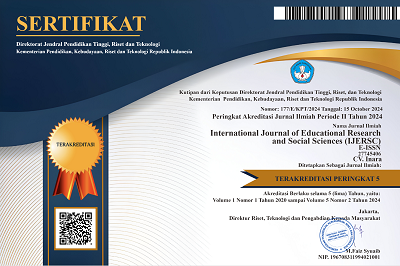Acceptance Analysis Of Mobile Learning Using The Unified Theory Of Acceptance And Use Of Technology (UTAUT): The Case Of Asynchronous Learners
DOI:
10.51601/ijersc.v4i1.580Published:
2023-02-27Downloads
Abstract
The purpose of this study is to assess the information technology students’ acceptance
of and intention to use mobile learning applications using the Unified Theory of
Acceptance and Use of Technology (UTAUT) model. The study, which involved a
first-year through fourth –year and even graduate students from the information
technology department, was carried out from January to June 2022. Eighty volunteers
participated in the study and completed the self-made questionnaire based on the
UTAT model’s five constructs: performance efficiency (PE), effort expectancy (EE),
social influence (SI), facilitating conditions (FC), and behavioral intention (BI).
Using the Cronbach’s alpha coefficient, the questionnaire’s acceptability and
reliability were also evaluated. The association between the five factors and the
intention to adopt mobile learning was also evaluated using regression analysis. The
study’s final score of α=0.080619 suggests that the contracted questionnaires were
good and acceptable. Four theories were put to the test, and the results indicate a
favorable impact on the behavioral intention to utilize mobile learning applications.
Future research should reevaluate the UTAUT model among students who are not
studying computer technology when an asynchronous style of learning is also relevant.
References
Chao, C.-M. (2019). Factors Determining the Behavioral Intention to Use Mobile Learning: An Aplication and
Extension of the UTAUT Model. Frontiers in Psychology, Volume 10, Article 1652 pp.1-14.
Corfman, T., & Beck, D. (2019). Case Study of Creativity in Asynchronous Online Discussions. International
Journal of Educational Technology in Higher Education, 22 (2019). https://doi.org/10.1186/s41239-019-
-5
Lakho, M., & Pitafi, A. (2019). UTAUT Model Towards Acceptance of E-Leaning through MOOCs. American
Based Research Journal, Vol.9, Issue 10. pp. 2304-7151. http://ww.abrj.org
Lin, C. (2019). Applying the UTAUT Model to Understand Factors Affecting the Use of E-books in Fujan ,
China. Fujan, China: University of Boras. URN: urn:nbn:se:hb:diva-23410
Mahande, R., & Malago, J. (2019). An E-Learning Acceptance Evaluation through UTAUT Model in a
Postgraduate Program. Journal of Educators Onlinie, Vol.16, No.2. DOI:10.9743/JEO.2019.16.2.7
Momani, A. (2020). The Unified Theory of Acceptance and Use of Technology: A New Approach in
Technology Acceptance. International Journal of Sociotechnology and Knowledge Development, 12(3):79-98
DOI:10.4018/IJSKD.2020070105.
Neelakandan, N. (2021). Benefits of Mobile Learning. eLearning Industry,
https://elearningindustry.com/benefits-and-challenges-of-mobile-learning.
Ngampornchai, A., & Adams, J. (2016). Students' Acceptance and Readiness for E-Learning in Northeastern
Thailand. International Journal of Educational Technology in Higher Education, 34(2016).
https://doi.org/10.1186/s41239-016-0034-x
Onaolapo, S., & Oyewole, O. (2018). Performance Expectancy, Effort Expectancy, and Facilitating Conditions
as Factors Influencing Smart Phones use for Mobile Learning by Postgraduate Students of the University of
Ibadan, Nigeria. Interdisciplinary Journal of E-Skills and Lifelong Learning, Vol.14, 95-115
https://doi.org/10.28945/4085.
Perveen, A. (2016). Synchronous and Asynchronous E-Learning: A Case Study of Virtual University.
International Council for Open and Distance Education, Vol.8, Issues1, pp. 21-39. DOI:
http://dx.doi.org/10.5944/openpraxis.8.1.212.
Stewart, M. (2019). The Limitations of Machine Learning. Towards Data Science,
https://towardsdatascience.com/the-limitations-of-machine-learning-a00e0c3040c6.
Team, L. (2021). The Importance of Mobile Learning. Lorman, https://www.lorman.com/blog/post/why-mobilelearning-is-important-2021.
Thomas, T., Singh, L., & Gaffar, K. (2013). The Utility of the UTAUT Model in Explaining Mobile Learning
Adoption in Higher Education in Guyana. International Journal of Education and Development using
Information and Communication Technology (IJEDICT), Issue 3, pp.71-85.
Wijaya, T., Cao, Y., Weinhandl, R., Yusron, E., & Lavicza, Z. (2022). Applying the UTAUT Model to
Understand Factors Affecting Micro-lecture Usage by Mathematics Teachers in China. Mathematics, 10(7),
doi.org/10.3390/math10071008.
License
Copyright (c) 2023 International Journal of Educational Research and Social Sciences (IJERSC)

This work is licensed under a Creative Commons Attribution 4.0 International License.






